Smallmouth bass lifespans vary dramatically by region, with southern populations typically living 7-11 years while northern bass in Canadian waters can exceed 20 years, thanks to cooler temperatures that slow metabolism. You’ll find that warmer climates accelerate growth but shorten lifespans, whereas colder environments promote longevity by reducing disease and parasites. The oldest recorded smallmouth bass reached an impressive 26 years in Ontario’s frigid waters, and exploring the complete life cycle reveals fascinating developmental patterns.
TLDR
- Smallmouth bass typically live 6-10 years, with southern populations averaging 10-11 years and northern populations reaching 15-18 years.
- Colder water temperatures significantly extend lifespan, with Canadian populations exceeding 20 years and record specimens reaching 26 years old.
- Rapid growth occurs during the first two years at 3.5-6 inches annually, then slows considerably as fish mature.
- Warmer southern climates accelerate growth rates but reduce lifespans to 7-9 years due to increased metabolism and stress.
- Environmental factors like water quality, habitat conditions, and forage availability directly influence both growth rates and overall longevity.
Average Lifespan Across Different Regions
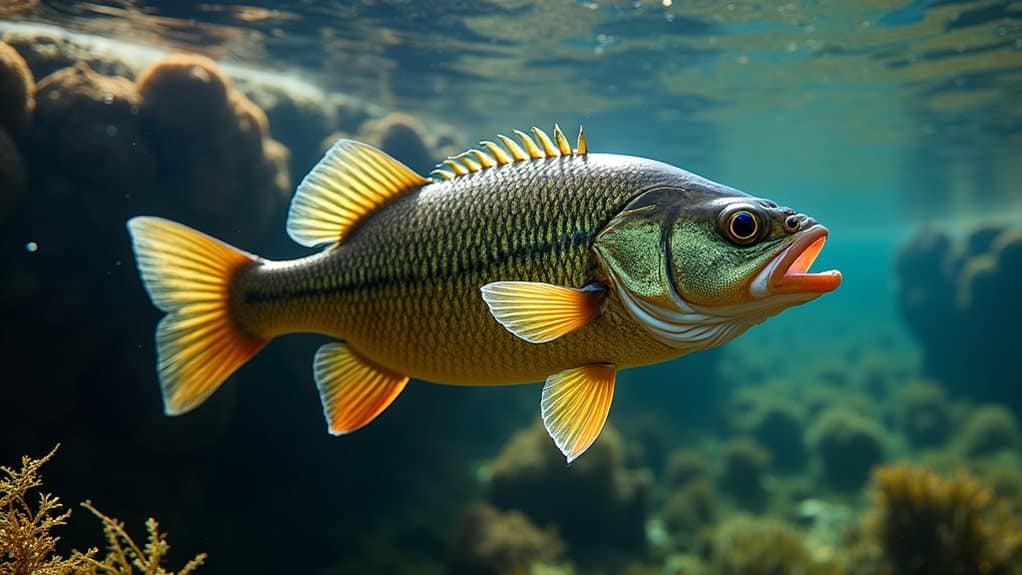
While smallmouth bass share similar biological characteristics across their range, their lifespans vary dramatically depending on where they live. You’ll find that southern populations typically live 10-11 years, while northern regions support fish into their teens. In Canada and Ontario, cooler waters can extend lifespans beyond 20 years, with some exceptional specimens reaching 26 years old. The oldest smallmouth bass recorded in Northwestern Ontario reached an impressive 23 years of age. This longevity is significant for sustainable fishing practices as it highlights the importance of regulating fish populations to ensure future generations can enjoy fishing.
Factors That Influence Longevity
Although smallmouth bass possess extraordinary genetic potential for longevity, their actual lifespan depends on a complex interplay of environmental and biological factors that you can observe across different water bodies. Water temperature greatly impacts longevity, with colder northern waters supporting lifespans of 15-18 years compared to warmer southern waters where bass typically live only 7-9 years. The faster growth rates and longer seasons in southern climates contribute to their shortened lifespan compared to their northern counterparts. Additionally, factors like deer feeding habits in the surrounding ecosystem can also indirectly affect the water quality and habitat, influencing the longevity of smallmouth bass.
Growth Rates and Maturity Timeline
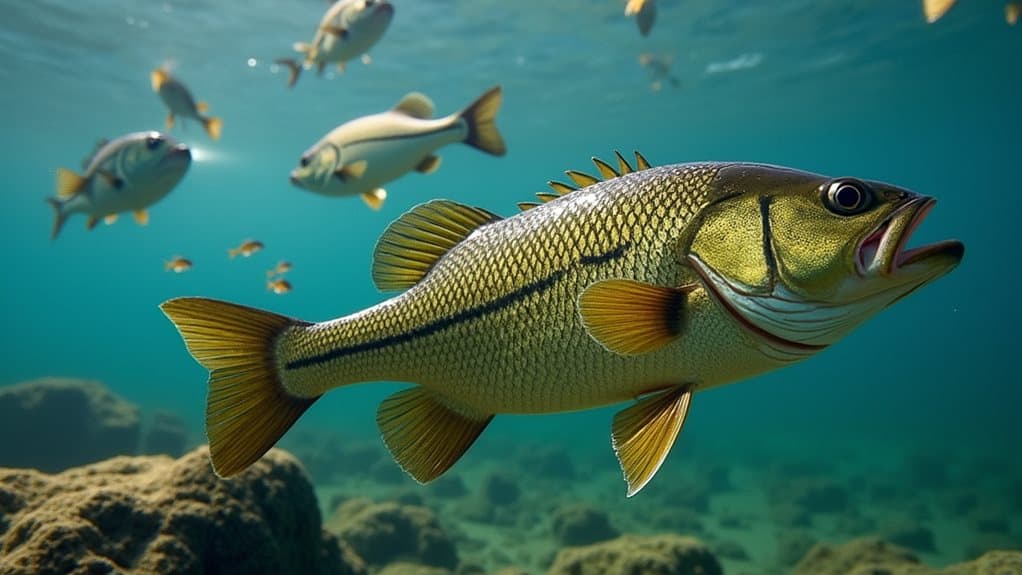
When examining how quickly smallmouth bass develop throughout their lives, you’ll find that growth rates vary dramatically based on several key environmental factors.
Water temperature, forage availability, and habitat type all influence development speed.
Generally, you can expect rapid growth during the first two years, reaching 3.5 to 6 inches annually, before slowing markedly thereafter. Additionally, understanding seasonal patterns can help anglers predict when smallmouth bass are most likely to be feeding, further impacting their growth.
Life Cycle Stages From Fry to Adult
Understanding these growth patterns provides important background for examining the specific developmental phases that shape a smallmouth bass’s path from egg to reproduction-ready adult.
You’ll observe distinct stages: hatching occurs within 2-10 days, followed by yolk sac absorption over 4-16 days.
Fry then school tightly while feeding on plankton, eventually becoming independent juveniles before reaching sexual maturity at 3-5 years. Additionally, rod and reel combos can enhance the fishing experience when targeting these fish at various life stages.
Temperature Effects on Bass Development
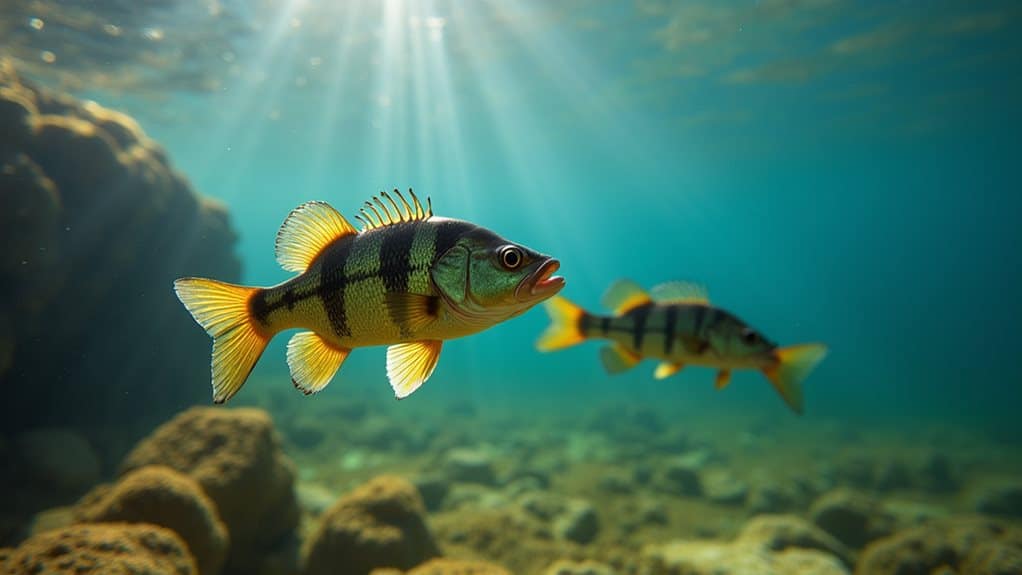
Temperature acts as nature’s thermostat for smallmouth bass development, controlling everything from how quickly your fish grow to how long they’ll ultimately live.
You’ll find that warmer waters push bass through their developmental stages faster, creating rapid growth but potentially shorter lifespans, while cooler climates slow the process down and often produce longer-lived, larger specimens.
These thermal gradients across different water bodies create distinct patterns in bass populations, shaping not only individual fish development but entire regional characteristics of the species.
Warmer Waters Accelerate Growth
As water temperatures rise within ideal ranges, smallmouth bass experience dramatically accelerated growth rates that can greatly impact their development timeline.
You’ll notice fry grow fastest at 25-27°C, while adults peak around 22°C.
However, warmer waters create a trade-off: they enhance early growth but may reduce ultimate size and longevity due to increased metabolic demands.
Cold Climates Extend Lifespan
While warmer waters enhance growth rates, cooler climates offer smallmouth bass a different advantage that proves equally beneficial over their lifetime.
You’ll find that bass in northern waters often outlive their southern counterparts due to slower metabolisms that reduce energy expenditure.
Cold environments also limit disease-causing parasites and pathogens that thrive in warmer conditions, naturally extending lifespans.
Thermal Gradients Shape Development
Beyond the simple influence of warm versus cold water lies a complex thermal environment that fundamentally shapes how smallmouth bass develop throughout their lives.
You’ll find that eggs show extraordinary resilience to temperature fluctuations, while larvae become more vulnerable when temperatures exceed ambient conditions by more than 12°C, creating critical windows for survival.
Habitat Impact on Survival Rates
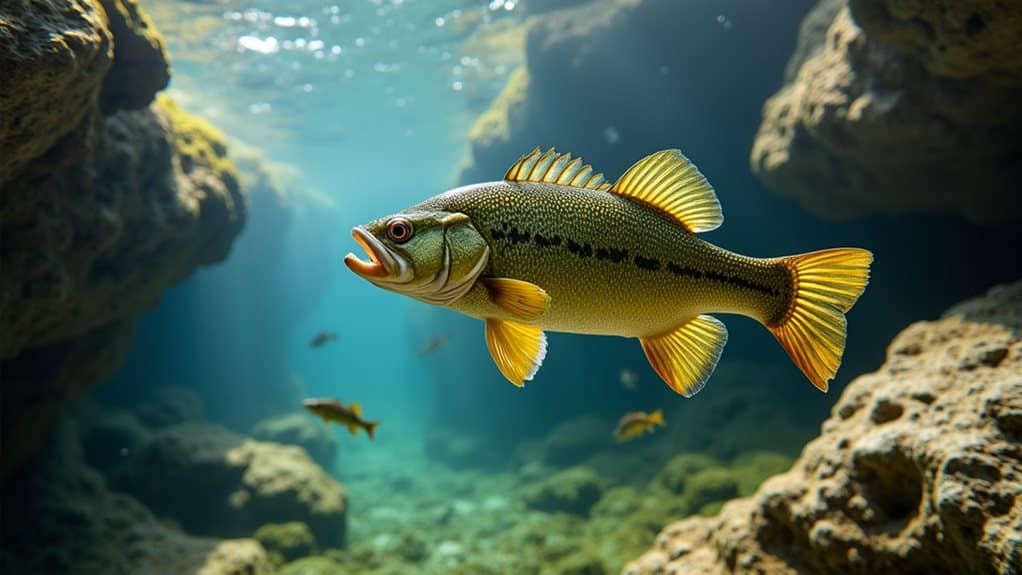
Your smallmouth bass’s survival depends heavily on where it lives, with temperature playing a vital role in determining how long these fish will thrive in their environment.
You’ll find that bass in northern waters with cooler temperatures typically live much longer than their southern counterparts, who face shortened lifespans due to warmer conditions and faster metabolic rates.
Competition from other species like largemouth bass, combined with varying habitat quality including food availability and shelter options, creates additional survival pressures that can greatly impact population success.
Temperature Effects on Longevity
As temperatures climb beyond ideal ranges, smallmouth bass face significant reductions in their lifespan, creating a critical connection between thermal conditions and long-term survival in their habitats.
You’ll find that higher mean annual temperatures directly correlate with shorter lifespans, while extended exposure above 29°C induces stress responses that compromise their long-term health and survival prospects.
Northern Vs Southern Waters
When examining smallmouth bass populations across their range, you’ll uncover that geography plays a decisive role in determining both lifespan and survival rates.
Northern waters support bass living 15-18 years due to cooler temperatures and shorter active seasons.
Southern populations typically survive only 7-9 years, experiencing faster growth but accelerated physiological aging from extended growing seasons.
Competition and Habitat Quality
Beyond geographic differences, habitat quality and competitive pressures create the most immediate survival challenges that smallmouth bass face throughout their lives.
You’ll find that dissolved oxygen below 2.5 ppm greatly reduces survival rates, while temperatures exceeding 30°C during summer droughts force bass into overcrowded pools.
This intensifies competition for limited resources, directly impacting their longevity and reproductive success.
Record-Breaking Ages and Notable Examples
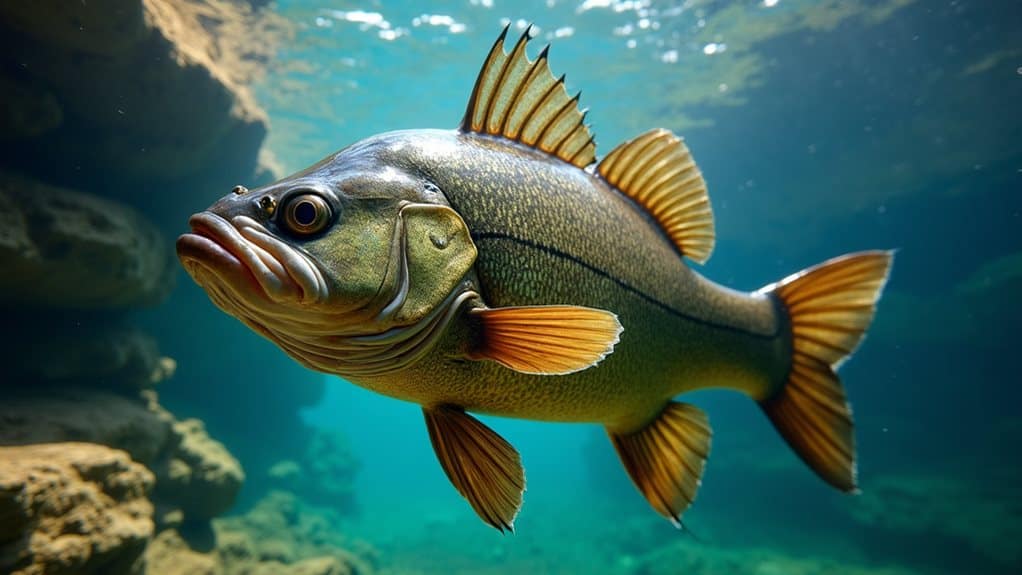
While most anglers expect their smallmouth bass to live somewhere between 6 to 10 years, exceptional individuals can far exceed these typical lifespans, with some extraordinary specimens reaching ages that challenge our understanding of the species’ longevity potential.
The most outstanding documented case reached 26 years, while a 16-year-old Ontario bass weighed 10.15 pounds.
Final Note
You’ll find that smallmouth bass typically live 10-16 years in the wild, though exceptional specimens can reach their early twenties. Their longevity depends heavily on water temperature, habitat quality, and fishing pressure in your local waters. Understanding their life cycle helps you become a better angler, as you’ll know when they’re spawning, feeding actively, or seeking deeper refuge. Remember that protecting these fish guarantees healthy populations for future generations of anglers.




